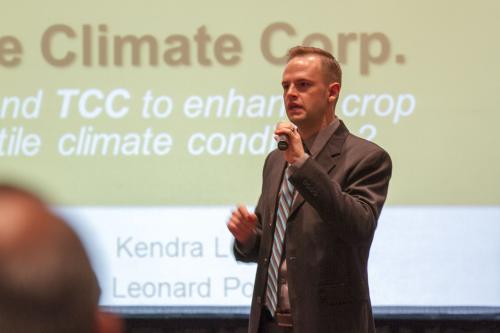Grad team wins 2015 IFAMA Case Competition
How comfortable is a fourth-generation Wisconsin dairy farmer analyzing a business plan before a panel of judges from the International Food and Agribusiness Management Association (IFAMA)? If that dairy farmer is Leonard Polizin -- very comfortable.

How comfortable is a fourth-generation Wisconsin dairy farmer analyzing a business plan before a panel of judges from the International Food and Agribusiness Management Association (IFAMA)?
If that dairy farmer is Leonard Polizin -- very comfortable.
Polzin, a master’s candidate in the agricultural, food and resource economics program at Michigan State, never felt more at home than in the final stage of the IFAMA Student Case Competition in St. Paul, Minnesota, in June. He and his case study competition teammates – Kendra Levine, Tatevik Avetisyan and Andrea Leschewski – secured the top prize among 20 international collegiate teams during the three-day conference. In doing so, the Spartan team convinced the judges they that they had the best plan for Monsanto and The Climate Corporation to leverage new acquisitions to help farmers maximize net returns per acre while better utilizing scarce land and water resources to feed a growing population.
Because he had participated in similar competitions, Polzin had an idea of which leading agribusiness and food industry companies might be represented on the judges panel. He also felt it was important for his team to present a big-picture solution to the problem and not get bogged down in strict detail.
 “It was important for us, as a team, to deliver a plan that showed our understanding of the problem and our awareness of companies facing these types of challenges,” Polzin said. “We put in weeks and hours of prep time before the conference to make sure each of us knew our role and what was expected of us as a team.”
“It was important for us, as a team, to deliver a plan that showed our understanding of the problem and our awareness of companies facing these types of challenges,” Polzin said. “We put in weeks and hours of prep time before the conference to make sure each of us knew our role and what was expected of us as a team.”
“One thing that really helped us was to focus on clarity in everything we presented, especially the visuals,” Levine said. “Our adviser [and coach], Dr. Brent Ross, made sure to emphasize that throughout our practice sessions leading up to the conference.”
MSU was one of four teams that advanced to the final round on June 16 and again went through a similar five-minute setup, 15-minute presentation and five-minute question-and-answer session in front of the four-person judges panel.
“We mastered how to brainstorm effectively in a very limited time,” Avetisyan said. “We knew how to identify the key problem in a case study and develop a strategic response, with a strong emphasis on teamwork.”
Levine credited the team’s diverse skill set for its ability to quickly size up the situation and produce a coherent plan:
- Avetisyan – business performance analysis, experience working with cooperatives in Armenia.
- Leschewski – a Ph.D. candidate well-versed in research and data analytics.
- Levine – PowerPoint pro, concise wordsmith, solution creation (she accepted a position with McDonald’s corporate office as a manager of U.S. supply chain sustainability in August 2015).
- Polzin – public speaking and presentation (he has accepted a position with University of Minnesota as an assistant extension professor in the Center for Farm Financial Management beginning in January 2016).
The MSU team arrived at the St. Paul Convention Center on June 14 and competed in the preliminary round the following day. Each of the 20 teams was given exactly four hours to analyze the case and create and submit a PowerPoint presentation to the judging panel. Teams were then given a one-hour break to prepare for the 15-minute presentation to the panel.
The following criteria were used to evaluate each of the presentations: situational analysis – appreciation of the problem and its strategic implications; pragmatism – appropriateness and applicability of the recommended solution; creativity and originality of the solution; PowerPoint quality; oral presentation quality and professionalism; effective responses to judges’ questions; inclusion of all team members in the presentation.
by Mark Meyer



 Print
Print Email
Email



